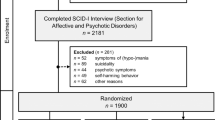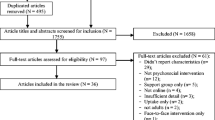Abstract
This study investigated predictors of adherence and outcome in a sample of callers to a national crisis telephone counseling service who were randomized to receive a 6-week, online, self-administered psychoeducation and cognitive behavioral therapy (CBT) intervention. Age, sex, relationship status, employment status, level of education, baseline depression symptom severity, and motivation to undertake the intervention were examined as predictors of adherence to the intervention in participants assigned to receive the online intervention (n = 83). Predictors of depression outcome were assessed using mixed models repeated measures ANOVA, comparing the two web-CBT intervention groups to the tracking and control groups (n = 155). Lower baseline depression severity was significantly associated with greater adherence to the intervention. A significant interaction was found between measurement occasion and motivation to undertake the intervention. At 6 month follow-up, participants with low and moderate levels of motivation had lower depressive symptoms than those with high levels of motivation. At 12 month follow-up, those with moderate levels of motivation had lower depressive symptoms than those with high motivation. The findings suggest that lower pre-intervention depression symptoms may positively influence adherence to online treatment for depression, while low and moderate levels of motivation appear to be optimal for treatment outcome. The factors that relate to adherence and outcome need to be understood to prevent dropout and maximize treatment effectiveness in online interventions.

Similar content being viewed by others
Explore related subjects
Discover the latest articles and news from researchers in related subjects, suggested using machine learning.References
Ajzen, I. (1991). The theory of planned behavior. Organizational Behavior and Human Decision Processes, 50, 179–211. Retrieved from http://www.journals.elsevier.com/organizational-behavior-and-human-decision-processes/.
Allart-van Dam, E., Hosman, C., & Keijsers, G. (2004). A new instrument to assess participant motivation for involvement in preventive interventions. Journal of Clinical Psychology, 60(6), 555–565. doi:10.1002/jclp.10236.
Andersson, G., Bergstrom, J., Holländare, F., Carlbring, P., Kaldo, V., & Ekselius, L. (2005). Internet-based self-help for depression: Randomised controlled trial. British Journal of Psychiatry, 187, 456–461. doi:10.1192/bjp.187.5.456.
Andersson, G., Bergström, J., Hollandare, F., Ekselius, L., & Carlbring, P. (2004). Delivering cognitive behavioural therapy for mils to moderate depression via the Internet: Predicting outcome at 6 month follow-up. Verhaltenstherapie, 14, 185–189. doi:10.1159/000080914.
Andersson, G., & Cuijpers, P. (2009). Internet-based and other computerized psychological treatments for adult depression: A meta-analysis. Cognitive Behaviour Therapy, 38(4), 196–205. doi:10.1080/16506070903318960.
Andrews, G., Cuijpers, P., Craske, M., McEvoy, P., & Titov, N. (2010). Computer therapy for the anxiety and depressive disorders is effective, acceptable and practical health care: A meta-analysis. PLoS One, 5(10), e13196. doi:10.1371/journal.pone.0013196.
Arnow, B., Blasey, C., Manber, R., Constantino, M., Markowitz, J., Klein, D., et al. (2007). Dropouts versus completers among chronically depressed outpatients. Journal of Affective Disorders, 97(1–3), 197–202. doi:10.1016/j.jad.2006.06.017.
Batterham, P., Neil, A., Bennett, K., Griffiths, K., & Christensen, H. (2008). Predictors of adherence among community users of a cognitive behavior therapy website. Patient Preference and Adherence, 2, 97–105. doi:10.2147/PPA.S.
Button, K. S., Wiles, N. J., Lewis, G., Peters, T. J., & Kessler, D. (2012). Factors associated with differential response to online cognitive behavioural therapy. Social Psychiatry and Psychiatric Epidemiology, 47(5), 827–833. doi:10.1007/s00127-011-0389-1.
Cavanagh, K., Shapiro, D., Van Den Berg, S., Swain, S., Barkham, M., & Proudfoot, J. (2009). The acceptability of computer-aided cognitive behavioural therapy: A pragmatic study. Cognitive Behaviour Therapy, 38(4), 235–246. doi:10.1080/16506070802561256.
Clarke, G., Eubanks, D., Reid, E., Kelleher, C., O’Connor, E., DeBar, L., et al. (2005). Overcoming depression on the Internet (ODIN) (2): A randomized trial of a self-help depression skills program with reminders. Journal of Medical Internet Research, 7(2), e16. doi:10.2196/jmir.7.2.e16.
Clarke, G., Reid, E., Eubanks, D., O’Connor, E., DeBar, L., Kelleher, C., et al. (2002). Overcoming depression on the Internet (ODIN): A randomized controlled trial of an Internet depression skills intervention program. Journal of Medical Internet Research, 4(3), e14. doi:10.2196/jmir.4.3.e14.
de Graaf, L., Hollon, S., & Huibers, M. (2010). Predicting outcome in computerized cognitive behavioral therapy for depression in primary care: A randomized trial. Journal of Consulting and Clinical Psychology, 78(2), 184–189. doi:10.1037/a0018324.
de Graaf, L., Huibers, M., Riper, H., Gerhards, S., & Arntz, A. (2009). Use and acceptability of unsupported online computerized cognitive behavioral therapy for depression and associations with clinical outcome. Journal of Affective Disorders, 116(3), 227–231. doi:10.1016/j.jad.2008.12.009.
de Haan, E., van Oppen, P., van Balkom, A., Spinhoven, P., Hoogduin, K., & Van Dyck, R. (1997). Prediction of outcome and early vs. late improvement in OCD patients treated with cognitive behaviour therapy and pharmacotherapy. Acta Psychiatrica Scandinavica, 96(5), 354–361. doi:10.1111/j.1600-0447.1997.tb09929.x.
Farrer, L., Christensen, H., Griffiths, K. M., & Mackinnon, A. (2011). Internet-based CBT for depression with and without telephone tracking in a national helpline: Randomised controlled trial. PLoS One, 6(11), e28099. doi:10.1371/journal.pone.0028099.
Griffiths, K., Farrer, L., & Christensen, H. (2010). The efficacy of internet interventions for depression and anxiety disorders: A review of randomised controlled trials. Medical Journal of Australia, 192(11 Suppl), S4–11. doi:http://www.mja.com.au/public/issues/192_11_070610/gri10844_fm.html.
Hamer, R., & Simpson, P. (2009). Last observation carried forward versus mixed models in the analysis of psychiatric clinical trials. American Journal of Psychiatry, 166, 639–641. doi:10.1176/appi.ajp.2009.09040458.
Hillis, G., Alexander, D., & Eagles, J. (1993). Premature termination of psychiatric contact. International Journal of Social Psychiatry, 39(2), 100–107. doi:10.1177/002076409303900203.
Hox, J. (2010). Multilevel analysis: Techniques and applications (2nd ed.). New York: Routledge.
Husaini, B., Neff, J., Harrington, J., Hughes, M., & Stone, R. (1980). Depression in rural communities: Validating the CES-D scale. Journal of Community Psychology, 8, 20–27. doi:10.1002/1520-6629(198001.
Jarrett, R., Eaves, G., Grannemann, B., & Rush, A. (1991). Clinical, cognitive, and demographic predictors of response to cognitive therapy for depression: A preliminary report. Psychiatry Research, 37(3), 245–260. doi:10.1016/0165-1781(91)90061-S.
Keijsers, G., Hoogduin, C., & Schaap, C. (1994). Predictors of treatment outcome in the behavioural treatment of obsessive–compulsive disorder. British Journal of Psychiatry, 165(6), 781–786. doi:10.1192/bjp.165.6.781.
Keithly, L., Samples, S., & Strupp, H. (1980). Patient motivation as a predictor of process and outcome in psychotherapy. Psychotherapy and Psychosomatics, 33(1–2), 87–97. doi:10.1159/000287417.
Kenardy, J., McCafferty, K., & Rosa, V. (2003). Internet-delivered indicated prevention for anxiety disorders: A randomized controlled trial. Behavioural and Cognitive Psychotherapy, 31, 279–289. doi:10.1017/S1352465803003047.
Kessler, R., Andrews, G., Colpe, L., Hiripi, E., Mroczek, D., Normand, S., et al. (2002). Short screening scales to monitor population prevalences and trends in nonspecific psychological distress. Psychological Medicine, 32, 959–976. doi:10.1017/S0033291702006074.
Knight, R., Williams, S., McGee, R., & Olaman, S. (1997). Psychometric properties of the Center for Epidemiologic Studies Depression Scale (CES-D) in a sample of women in middle life. Behavior Research and Therapy, 35(4), 373–380. doi:10.1016/S0005-7967(96)00107-6.
Lange, A., Rietdijk, D., Hudcovicova, M., van de Ven, J.-P., Schrieken, B., & Emmelkamp, P. (2003). Interapy: A controlled randomized trial of the standardized treatment of posttraumatic stress through the Internet. Journal of Consulting and Clinical Psychology, 71(5), 901–909. doi:10.1037/0022-006X.71.5.901.
Last, C., Thase, M., Hersen, M., Bellack, A., & Himmelhoch, J. (1985). Patterns of attrition for psychosocial and pharmacologic treatments of depression. Journal of Clinical Psychiatry, 46(9), 361–366. Retrieved from https://www.psychiatrist.com/default2.asp?tab=2.
Oei, T., & Kazmierczak, T. (1997). Factors associated with dropout in a group cognitive behaviour therapy for mood disorders. Behavior Research and Therapy, 35(11), 1025–1030. doi:10.1016/S0005-7967(97)00060-0.
Pekarik, G. (1985). Coping with dropouts. Professional Psychology: Research and Practice, 16(1), 114–123. doi:10.1037/0735-7028.16.1.114.
Pekarik, G. (1986). The use of termination status and treatment duration patterns as an indicator of clinical improvement. Evaluation and Program Planning, 9(1), 25–30. doi:10.1016/0149-7189(86)90004-2.
Radloff, L. (1977). The CES-D scale: A self-report depression scale for research in the general population. Applied Psychological Measurement, 1, 385–401. doi:10.1177/014662167700100306.
Ritterband, L., Thorndike, F., Cox, D., Kovatchev, B., & Gonder-Frederick, L. (2009). A behavior change model for internet interventions. Annals of Behavioral Medicine, 38(1), 18–27. doi:10.1007/s12160-009-9133-4.
Roberts, R. (1980). Reliability of the CES-D Scale in different ethnic contexts. Psychiatry Research, 2, 125–134. doi:10.1016/0165-1781(80)90069-4.
Roberts, R., & Vernon, S. (1983). The Center for Epidemiologic Studies Depression Scale: It’s use in a community sample. American Journal of Psychiatry, 140, 41–46. Retrieved from http://ajp.psychiatryonline.org/journal.aspx?journalid=13.
Ross, C., & Mirowsky, J. (1984). Components of depressed mood in married men and women: The Center for Epidemiologic Studies Depression Scale. American Journal of Epidemiology, 119(6), 997–1004. Retrieved from http://aje.oxfordjournals.org/.
Sotsky, S., Glass, D., Shea, M., Pilkonis, P., Collins, J., Elkin, I., Watkins, J., Imber, S., Leber, W., Moyer, J., & Oliveri, M. (1991). Patient predictors of response to psychotherapy and pharmacotherapy: Findings in the NIMH Treatment of Depression Collaborative Research Program. Americal Journal of Psychiatry, 148(8), 997–1008. Retrieved from http://ajp.psychiatryonline.org/journal.aspx?journalid=13.
Spek, V., Nyklicek, I., Cuijpers, P., & Pop, V. (2008). Predictors of outcome of group and internet-based cognitive behavior therapy. Journal of Affective Disorders, 105(1–3), 137–145. doi:10.1016/j.jad.2007.05.001.
SPSS Inc. (2009). PASW Release 18.0: SPSS Inc.
StataCorp. (2007). Stata Statistical Software: Release 10.1. College Station, TX: StataCorp LP.
Thase, M., Simons, A., McGeary, J., Cahalane, J., Hughes, C., Harden, T., & Friedman, E. (1992). Relapse after cognitive behavior therapy of depression: Potential implications for longer courses of treatment. American Journal of Psychiatry, 149(8), 1046–1052. Retrieved from http://ajp.psychiatryonline.org/journal.aspx?journalid=13.
van Straten, A., Cuijpers, P., & Smits, N. (2008). Effectiveness of a web-based self-help intervention for symptoms of depression, anxiety, and stress: Randomized controlled trial. Journal of Medical Internet Research, 10(1), e7. doi:10.2196/jmir.954.
Warmerdam, L., van Straten, A., Twisk, J., Riper, H., & Cuijpers, P. (2008). Internet-based treatment for adults with depressive symptoms: Randomized controlled trial. Journal of Medical Internet Research, 10(4), e44. doi:10.2196/jmir.1094.
Weinberger, J., & Eig, A. (1999). Expectancies: The ignored common factor in psychotherapy. In I. Kirsch (Ed.), How expectancies shape experience (pp. 357–382). Washington, DC: American Psychological Society.
Westra, H., Dozois, D., & Boardman, C. (2002). Predictors of treatment change and engagement in cognitive-behavioral group therapy for depression. Journal of Cognitive Psychotherapy, 16(2), 227–241. doi:10.1891/jcop.16.2.227.63996.
Whooley, M. A., Avins, A. L., Miranda, J., & Browner, W. S. (1997). Case-finding instruments for depression. Two questions are as good as many. Journal of General Internal Medicine, 12(7), 439–445. doi:10.1046/j.1525-1497.1997.00076.x.
Wierzbicki, M., & Pekarik, G. (1993). A meta-analysis of psychotherapy dropout. Professional Psychology: Research and Practice, 24(2), 190–195. doi:10.1037/a0021175.
Williams, J. W., Jr., Pignone, M., Ramirez, G., & Perez Stellato, C. (2002). Identifying depression in primary care: A literature synthesis of case-finding instruments. General Hospital Psychiatry, 24(4), 225–237. doi:10.1016/S0163-8343(02)00195-0.
Acknowledgments
The trial on which this paper is based was funded by an Australian Research Council Linkage Project Grant (LP0667970). K.M.G. is supported by a National Health and Medical Research Council Fellowship (525413). H.C. is supported by a National Health and Medical Research Council Fellowship (525411). P.J.B. is supported by a National Health and Medical Research Council Early Career Fellowship (1035262). Nicole Hayes (nee Burgess) coordinated and conducted data collection for the trial. Dawn O’Neil was involved in obtaining funding for the trial and coordinating Lifeline Australia’s collaboration with the ANU. Associate Prof Richard O’Kearney provided guidance on the background to this study. Trevor Carlyon was also involved in coordinating Lifeline staff and volunteer involvement in the trial and supported Nicole in her role.
Author information
Authors and Affiliations
Corresponding author
Rights and permissions
About this article
Cite this article
Farrer, L.M., Griffiths, K.M., Christensen, H. et al. Predictors of Adherence and Outcome in Internet-Based Cognitive Behavior Therapy Delivered in a Telephone Counseling Setting. Cogn Ther Res 38, 358–367 (2014). https://doi.org/10.1007/s10608-013-9589-1
Published:
Issue Date:
DOI: https://doi.org/10.1007/s10608-013-9589-1




